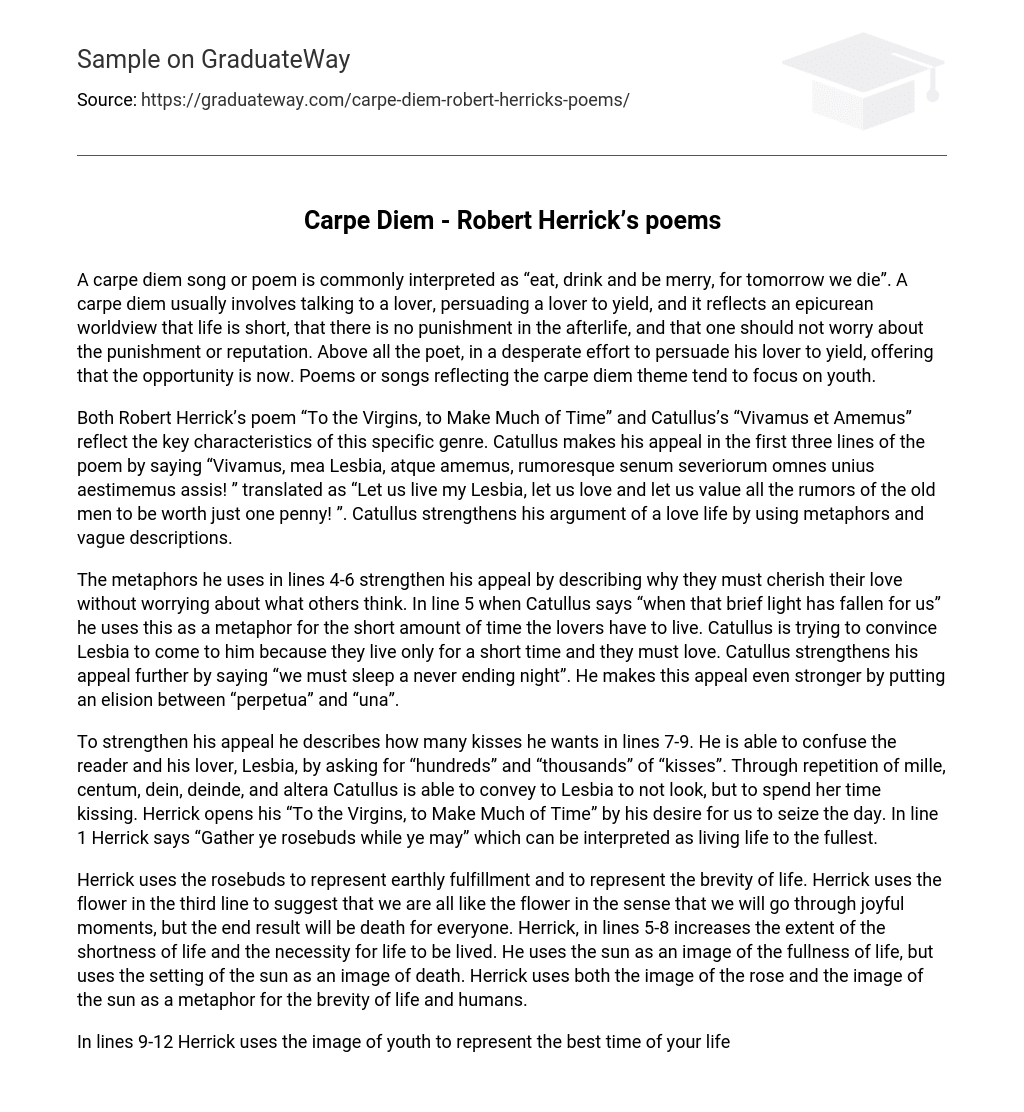The concept of carpe diem, often expressed through songs or poems, is often understood as the notion of “eat, drink and be merry, for tomorrow we die”. Carpe diem typically involves conversing with a lover and urging them to embrace the moment, reflecting a hedonistic worldview that life is short, the afterlife does not entail punishment, and one should not be concerned about their reputation or consequences. Above all, the poet, in a desperate attempt to persuade their lover, emphasizes that the opportunity is presently available. Poems or songs embodying the carpe diem theme frequently center around youth.
Both Robert Herrick’s poem “To the Virgins, to Make Much of Time” and Catullus’s “Vivamus et Amemus” exemplify the characteristic elements of this particular genre. In the first three lines of his poem, Catullus presents his appeal by urging, “Let us live, my Lesbia, let us love, and let us deem all the rumors of stern old men worth just one penny!” Catullus enhances his argument for a passionate love life through the use of metaphors and ambiguous descriptions.
The author’s persuasive appeal is reinforced by the metaphors used in lines 4-6, which highlight the importance of cherishing their love without being concerned about others’ opinions. In line 5, the phrase “when that brief light has fallen for us” metaphorically represents the limited time the lovers have to live. Catullus endeavors to persuade Lesbia to be with him by emphasizing that their lives are short and they must love each other during this time. Furthermore, Catullus strengthens his appeal by stating that they “must sleep a never ending night,” accentuated by the elision between “perpetua” and “una.”
To strengthen his appeal, Catullus describes his desire for numerous kisses in lines 7-9. He confuses both the reader and his lover, Lesbia, by requesting “hundreds” and “thousands” of kisses. Through the repetition of mille, centum, dein, deinde, and altera, Catullus effectively communicates to Lesbia that she should not waste her time looking around, but instead spend her time kissing. Similarly, in his poem “To the Virgins, to Make Much of Time,” Herrick expresses his desire for us to seize the day. In line 1, Herrick urges us to “Gather ye rosebuds while ye may,” encouraging us to live life to the fullest.
Herrick employs the rosebuds to symbolize both earthly fulfillment and the transient nature of life. In the third line, he utilizes the flower to suggest that all of us, like the flower, will experience moments of happiness but ultimately face mortality. Further emphasizing the briefness of life and emphasizing the importance of living it, Herrick employs the sun as a representation of life’s abundance, while also using the setting of the sun as a symbol of death. By employing both the image of the rose and the image of the sun, Herrick metaphorically conveys the fleetingness of human existence.
Herrick utilizes the concept of youth in lines 9-12 to symbolize the prime period of one’s existence and urges us to relish it. He emphasizes that love occupies a special place in a person’s life and advises us to seize it when it presents itself. In the final four lines, Herrick connects all aspects of life and unites them through the institution of marriage. While Catullus and Herrick employ contrasting approaches to express their carpe diem philosophy, they both share elements of an epicurean argument and the components that constitute a carpe diem mindset.
Both Herrick and Catullus encourage their respective lovers to embrace life and take risks. Herrick’s poem emphasizes the importance of seizing the present moment, while Catullus urges his lover to disregard the opinions of others and indulge in impulsive actions. Both poets aim to persuade their lovers to join them in their pursuit of a fulfilling life. While Herrick does not discuss the consequences of the afterlife or the significance of reputation, he does touch on themes commonly found in Catullus’ work, such as addressing a beloved and highlighting the brevity of life.





